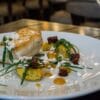If you go down to the woods today…you’d better take a basket. Elise Rana Hopper goes foraging for fungi and learns that there’s more to mushrooms than meets the eye
A damp autumnal afternoon in Hamsterley Forest, Co Durham, and a dozen or so strangers are gathering around one man and the boot of his car, the tiny silver stud in his left earlobe giving a hint to the kind of pharmacopeia contained within. We’re about to embark on a guided foray with mushroom expert Dominique Colback, and our journey of discovery starts with something familiar.
“Cep, Penny Bun, Boletus Edulis…usually it’s when I say Porcini that most people get excited,” says Dominique, holding aloft a single specimen that would cost upwards of a tenner if you were lucky enough to find one at your local market. “We have Italian chefs to thank for that.”
The UK is home to an estimated 10,000-15,000 types of wild fungi, yet it has taken the likes of Antonio Carluccio to make us aware of the culinary treats we might be missing out on – something I’m hoping to put right today, if only I can keep up.
We’ve barely walked a minute before Dominique is rummaging in the leaf litter beneath an oak tree. “Hmm…we’ve already found our first unidentifiable,” he says. “Let’s call this an LBJ – little brown job, to borrow a term from the birders.” Marching briskly up the path, after a brief swerve to inspect a bilberry bush (good Chanterelle potential, apparently), he steers our band of foragers off-road into the forest and sends us all off into the undergrowth to see what we can find.
While we’re focused on potential edibles, the kids are immediately absorbed in the treasure hunt thrill of foraging for fun alone, bounding up to Dominique with a new find every couple of minutes. “Ah, now I like that,” he says, lifting one to his nostril and taking a deep sniff before passing it round and inviting us to do the same. This tiny object packs a pungent odour of burnt rubber “Lepiota Cristata,” he says, “Stinking Parasol. Toxic.” And drops it into his basket.
A few minutes later, several baskets of weird and wonderful species are returned for identification, from a gigantic, frisbee-esque polypore to a miniscule delicate Horsehair fungus. There’s a dog-eared Saffron Milkcap, a thumb-sized jelly fungus, a yellow Stagshorn no bigger than a fingernail. Many transpire to be the same thing, such as the Sulphur Tuft that turns from bright yellow to almost black, and the gamut of purple-red Russulas nicknamed ‘Dulux’ due to their range of colour.
“Now that’s quite nice – Helvella Crispa,” says Dominique, as my youngest proffers what looks like a used tissue but turns out to be the wonderfully named Elfin Saddle. “The books say it’s edible, but, well, my dad used to eat anything marked E for ‘edible’ but I tend to stick to ‘edible and good’. Too many Es of disappointment.”
One couple look to have hit the jackpot, wielding a Cep the size of a butternut squash. “Let’s see if you’ve been lucky,” says Dominique, and begins to slice sections from the stem to reveal the tiny wriggling beasties already tucking in. “You’ve got to beat the fly to the cap – or you’ll get a bit more protein than you bargained for.”
We press on and more finds abound, though excitement at any potential edibles is tempered by words of caution. The Amethyst Deceiver is “edible, and nice – but should never be picked near mining sites, as it collects arsenic.” Amanita Rubescens, aka the blusher, looks very similar to the deadly Panther Cap and contains haemolytic toxins when raw – but is quite nice when fried.
The general theme is that for every rule, there are as many exceptions, and each characteristic gives only a hint towards identification. Seasoned foragers note everything, from the size, shape and colour of every part to how it smells, bruises or breaks, what it’s growing in, under and next to. Those who plan to eat their harvest are advised to consume no more than one square inch of a species at a time, as variable reactions can occur in different people, and sensitivity can develop suddenly after years of tolerance. Even ‘safe’ species can prove toxic in quantity – the previously prized edible Tricholoma Equestre or Yellow Knight caused several hospitalisations in South West France after a glut encouraged foragers to over-indulge in the bounty. Unless you’re 100% sure of what you’ve got, don’t eat it. Heed the tale of Horse Whisperer author Nicholas Evans, who left himself and his family with acute renal failure after the wild mushrooms he picked and cooked for them turned out to be the highly toxic Deadly Webcap.
The lethal potential of these evocatively named organisms – Deathcap, Destroying Angel, the Sickener, Poison Pie – are a reminder that despite appearances, there is nothing humble about the mushroom. Indeed, they’re part of a mysterious underworld that’s one of biology’s final frontiers. Of an estimated couple of million species of fungi, around 150,000 form mushrooms, fewer than 10% of which have been identified.
And the mushrooms are merely the fruiting body of the mycelium, a fascinatingly complex, self-repairing network of cells that infuses the soil, whose architecture has been found to conform to the same mathematical optimisation curves as the Internet. Not only that, but these fungal networks provide communication services to plants and other organisms in what biologists term the ‘wood wide web’. It’s kind of mind-blowing stuff.
Indeed, many mycologists are disapproving of collecting at all – at best, the advice is never to remove all the mushrooms from a site.
Of the multitude my enthusiastic little foragers have harvested, our edible haul whittles down to four small hedgehog mushrooms which we carefully transport home. As the Internet advises, we shave the characteristic little spines from beneath the cap, slice them and fry them in butter. It’s a modest meal, but sharing the fruit of our afternoon’s adventure is a tasty delight.
I may have a lot to learn, but you can bet that next time we’re heading for the woods, I’m bringing a basket.
Recipe: Mushroom and Sausage Casserole
Recipe: Mushroom, Spinach, Kale and Sweet Potato Pie












